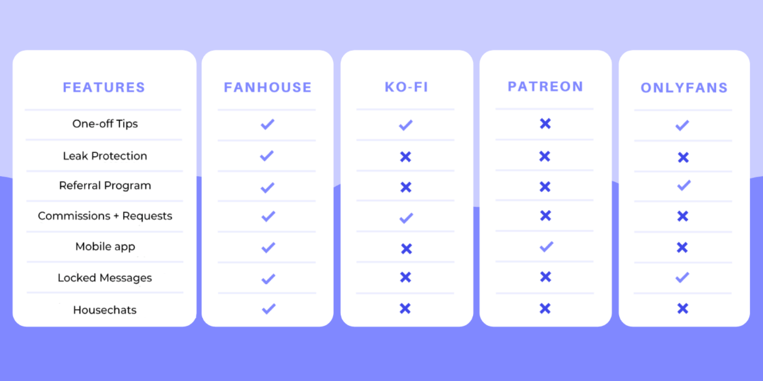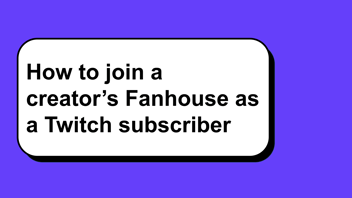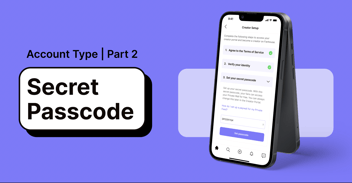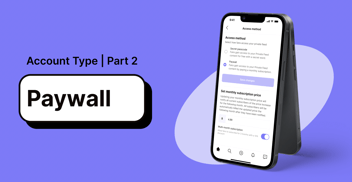Considering monetizing your social media content, but you’re not sure what platform is right for you? We’re here to help you weigh up your options as best we can.
For each platform, we’ll cover the monetization options, revenue splits, general feature comparisons, and how they handle creator safety.
Content Monetization
One of the main uses for each of platforms available to content creators is, of course, monetizing your content. But each platform sets up the timing and flexibility of this monetization in a different way.
On Fanhouse, you have the option to set a subscription price per month to allow subscribers into your Fanhouse. You can also offer free trial codes, which give people a free month of your Fanhouse before renewing at your regular subscription price. Secret passcodes offer greater access to your Fanhouse and allow fans to join for free. From there, fans can tip you on posts or through DMs, and pay to unlock messages and posts. Fanhouse also has a custom requests list feature, where you can list whatever you’d like for your fans to “purchase” from you.
On Patreon, subscriptions serve as the main driver of income. Creators can create tiers at different price points, and their community can choose which tier they’d like to pledge to each month. Patreon allows creators to price tiers either at a certain price per month, or per piece of content posted.
Ko-fi has a few more options than Patreon, while also having tiers if you use Ko-fi Gold. People can tip you as a one-off, or every month. Ko-fi also allows you to open up a “shopfront” where you can sell digital and physical products, and a commissions list where you can sell commissioned works. These are free with Ko-fi Gold ($4.50 — $6 a month) or an extra 5% platform fee if you’re not on Ko-fi Gold.
Onlyfans is the most similar to Fanhouse in terms of monetization. As well as paying a set subscription price per month, fans can also tip on individual posts, or through DMs. Creators can also send out locked messages, which are set at a certain price of their choosing. Onlyfans also lets you offer discounts on subscribing for a certain amount of months at once. Onlyfans is unique in that it gives creators the option to run a free page while still making money. You can have a page that costs nothing to “subscribe” to, while still sending out priced locked messages and receiving tips in DMs and on posts.
Platform Feature Comparison
We created a handy-dandy table to compare which platforms have which features, in case something is a must for you! If you want to know the difference between how certain features work on other platforms compared to Fanhouse — for example, what is different about DMs on Patreon compared to DMs on Fanhouse? — we intend to dive into that in future articles!

- Patreon: Tags to categorise your content, facilitation of physical rewards.
- Fanhouse: Housechats, built-in watermarks, being lifetime mutuals for free with other creators.
- Ko-fi: A dedicated shopfront if you use Ko-fi Gold (or use free Ko-fi, and pay a 5% fee.)
- Onlyfans: A “Story” feature, like Instagram’s.
Creator Platform Fees: Fanhouse Only Takes 10%
All of these platforms take a fee from creators’ earnings, as they’re hosting and facilitating the content. An important thing to keep in mind when deciding which platform gives you a higher take rate is withdrawal and transaction fees. Platforms don’t mention those when quoting how much their fee is — Patreon earnings being subject to a withdrawal fee from PayPal isn’t Patreon’s fee.
Fanhouse takes 10% of all revenue on the platform. Any processing fees are on the side of the subscriber, meaning that if you send a picture out for $15, the subscriber will purchase it for $15.74. They pay the processing fee, not the creator. There’s also no withdrawal fees for transferring your Stripe balance to your bank — we cover that ourselves. So when we say that we pay you 90% of your earnings with us, we mean it.
Patreon’s take rate varies. Depending on which of their three plans you choose, they take between 5–12%, followed by possible currency conversion fees and processing fees. You’re charged a fee per payout, which can be between $0.25 — $1.40 depending on what country you’re in and what withdrawal method you’ve chosen. You can read more about their payout fees here.
Ko-fi takes 0%, unless you sign up for Ko-fi Gold (which unlocks membership tiers and commissions, among other features). Ko-fi Gold is $4.50 — $6 a month. When withdrawing from Ko-fi via Stripe or Paypal, you are subject to their transaction fees of 2–3.4% + $0.30. If you’d like to set up the ability to subscribe to you on Ko-fi, you need Ko-fi Gold or pay a 5% fee.
Onlyfans has the highest fee — 20% of total earnings. Whether you need to pay transaction + withdrawal fees on top is unclear without making an account, because they don’t have a webpage available detailing their payout scheme.
Fanhouse was Built by Creators, For Creators
Something that sets Fanhouse apart from many of the other platforms in this blog is that there is a content creator on the founding team. Jasmine, one of the founders of Fanhouse, is a content creator who’s spent year monetizing on various platforms including Twitch, Twitter and Onlyfans.

Our community management team is also made up of creators. This means that we can talk the talk and truly walk the walk when it comes to prioritizing and understanding creators.
Because of Jasmine’s experience as a female creator, Fanhouse builds a platform specifically with women and marginalized creators in mind. Onlyfans and Ko-fi were not founded by creators. This by no means indicates that they don’t understand creators — they have community management teams, and stay connected with their users as much as any other platform. But Fanhouse always has a creator’s perspective first and foremost in everything we do, which is invaluable in a time when many corporations exploit creators as the creator economy grows.
Creator Platform Safety
Having your content leaked outside of your paywall is a severe breach of trust and privacy. Creators work hard on their content, other people don’t deserve to profit off of stealing it or circulate content among people that aren’t paying the creator for said content. It’s important to consider which platforms prioritize your safety and whether they help you to prevent content fraud where possible.
Fanhouse advertises a response rate of 1–2 business days for responding to leaks. Our watermarking system means that we can trace a leak back to its origin, so we can ban the exact leaker and fine them. We send out DMCA notices to leakers on a creators’ behalf. No system is perfect, and we can’t take down every post and fine every leaker (especially if a creator has watermarks turned off), but we try our best and are as transparent as can be with creators about how the process goes.
Patreon’s Piracy FAQ is available here. They encourage creators to file DMCA reports themselves, while offering help through email as needed. They do not fine leaks, and do not have a built-in watermarking feature. Creators would need to watermark their content themselves (although it’s impossible to watermark anything sent to an individual).
Ko-fi does not have any information available on their site about how they protect creators’ content, leaks, or DMCA.
OnlyFans advises that creators contact them at a certain email, and has a DMCA form available for download similar to Patreon. It’s unclear exactly what their process is, and on Reddit many creators advise about third-party websites that they use for protection. (From our co-founder’s personal experience, they don’t respond to emails, do nothing about leaks, and to this day she still finds her OF leaks across the internet.)
Creator Platform Branding
If you want to keep your community’s impression of each platform in mind, it’s important to consider what each platform is “known” for!
Fanhouse brands as a behind-the-scenes “finsta” or private Twitter. It’s a platform where creators are encouraged to take the pressure off themselves and just post what they want, when they want. Most of all, it’s about connecting with your community while having fun and getting paid. Patreon is popular with artistic creators such as podcasters, writers and cosplayers. OnlyFans, despite accepting non-adult content, is known for adult content and 98% of its creators are sex workers. Ko-Fi is often used by artists who accept commissions or want to sell physical goods, due to its in-built shopfront.
Every platform has its own advantages and disadvantages, as well as its own culture and community. So we can’t speak to what would work perfectly for every individual. What we do know is that Fanhouse is the only one by creators, for creators, and that we’re developing features as quickly as we can to accommodate for the needs of our userbase. We prioritize user experience and safety over everything, and believe that sets us apart from many creator platforms. If you’d like more details on the ins and outs of each platform, we plan on releasing more blogs soon! Don’t forget to follow our Instagram and Twitter for updates and tips.
.png?width=1920&height=680&name=FH_Wordmark_Blurple_Transparent%20(1).png)


